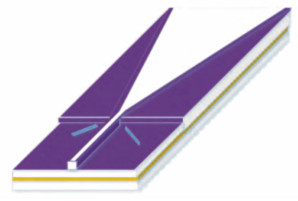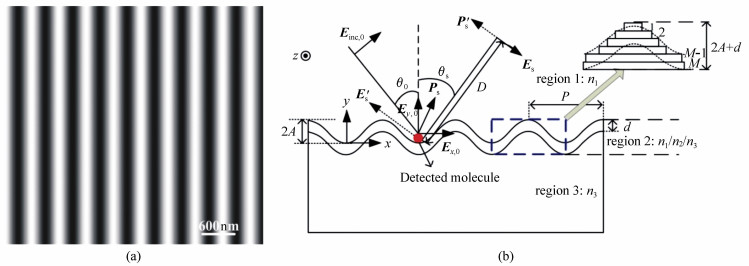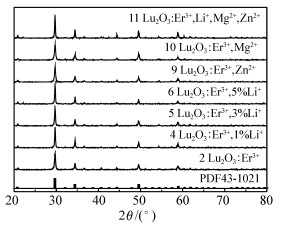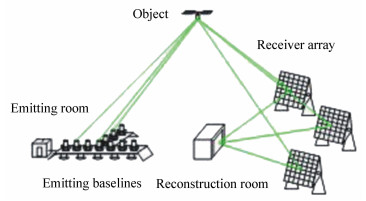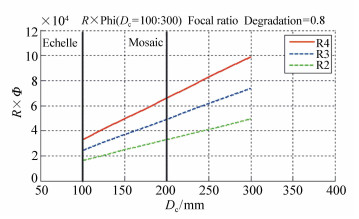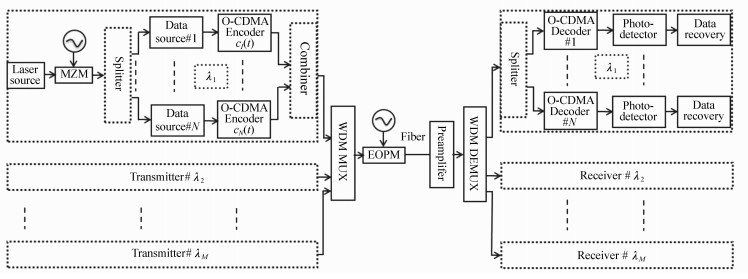2019 Vol. 12, No. 1
2019, 12(1): 1-18.
doi: 10.3788/CO.20191201.0001
Abstract:
Terahertz (THz) waves are characteristic for their low photon energy and fingerprint spectrum and ability to penetrate a large number of nonpolar materials. They have shown many unique advantages in areas such as nondestructive testing, security inspection, biological diagnosis and art identification. Three-dimensional THz tomographic imaging is especially useful for its ability to detect information inside samples. It is becoming a hot research topic and show great promise for future development. In this paper, some typical THz three-dimensional imaging techniques are introduced, along with their basic principles and some potential research advancements. Some existing problems are described and some areas for future development trends are proposed.
Terahertz (THz) waves are characteristic for their low photon energy and fingerprint spectrum and ability to penetrate a large number of nonpolar materials. They have shown many unique advantages in areas such as nondestructive testing, security inspection, biological diagnosis and art identification. Three-dimensional THz tomographic imaging is especially useful for its ability to detect information inside samples. It is becoming a hot research topic and show great promise for future development. In this paper, some typical THz three-dimensional imaging techniques are introduced, along with their basic principles and some potential research advancements. Some existing problems are described and some areas for future development trends are proposed.
2019, 12(1): 19-37.
doi: 10.3788/CO.20191201.0019
Abstract:
Silicon-based photodetectors are beneficial for their reliability, integration, scalability and low cost. However, due to their shallow penetration depth for UV radiation, conventional silicon devices have very limited ultraviolet responses. Motivated by the progress of silicon-based semiconductor processing techniques and nanoscience, UV-enhanced silicon-based photodetectors have been well developed and broadly applied. In this paper, we review the progress of this technology, its materials, its processing techniques and its applications in astrophysics, biochemical analysis and corona detection, and discuss the challenges and future prospects of silicon-based UV detection in sensitive imaging technologies.
Silicon-based photodetectors are beneficial for their reliability, integration, scalability and low cost. However, due to their shallow penetration depth for UV radiation, conventional silicon devices have very limited ultraviolet responses. Motivated by the progress of silicon-based semiconductor processing techniques and nanoscience, UV-enhanced silicon-based photodetectors have been well developed and broadly applied. In this paper, we review the progress of this technology, its materials, its processing techniques and its applications in astrophysics, biochemical analysis and corona detection, and discuss the challenges and future prospects of silicon-based UV detection in sensitive imaging technologies.
2019, 12(1): 38-47.
doi: 10.3788/CO.20191201.0038
Abstract:
Blue-violet lasers and mid-infrared lasers play an important role in the fields of basic research and defense engineering. Single-photon absorption alkali vapor lasers have recently become an area of high interest in laser research for their key advantages, such as high quantum efficiency, large stimulated emission cross-sections and effective thermal management performance. At present, they have achieved an output power reaching 1 kW. Two-photon absorption alkali vapor lasers have attracted increasing attention for their blue-violet laser and mid-infrared laser cascade output characteristics. In this paper, research progress on the two-photon absorption alkali vapor laser is reviewed with regards to alkali atomic density, pump laser power, polarization and frequency offset, controlling laser etc.. The reasons for any influence these factors have on output are then analyzed. Finally, predictions on the future development of the two-photon absorption alkali vapor laser are provided.
Blue-violet lasers and mid-infrared lasers play an important role in the fields of basic research and defense engineering. Single-photon absorption alkali vapor lasers have recently become an area of high interest in laser research for their key advantages, such as high quantum efficiency, large stimulated emission cross-sections and effective thermal management performance. At present, they have achieved an output power reaching 1 kW. Two-photon absorption alkali vapor lasers have attracted increasing attention for their blue-violet laser and mid-infrared laser cascade output characteristics. In this paper, research progress on the two-photon absorption alkali vapor laser is reviewed with regards to alkali atomic density, pump laser power, polarization and frequency offset, controlling laser etc.. The reasons for any influence these factors have on output are then analyzed. Finally, predictions on the future development of the two-photon absorption alkali vapor laser are provided.
2019, 12(1): 48-58.
doi: 10.3788/CO.20191201.0048
Abstract:
Tapered semiconductor lasers are characterized by high power and high beam quality. As a result, they have attracted much attention and have become a widely researched topic. This review focuses on the three main structures of tapered semiconductor diode lasers:the traditional structure, the distributed Bragg reflector(DBR) structure and the lateral grating structure. This paper summarizes the results of domestical and international representative research from the past ten years, introduces its theoretical research and experimental progress, and predicts the future development of tapered semiconductor lasers.
Tapered semiconductor lasers are characterized by high power and high beam quality. As a result, they have attracted much attention and have become a widely researched topic. This review focuses on the three main structures of tapered semiconductor diode lasers:the traditional structure, the distributed Bragg reflector(DBR) structure and the lateral grating structure. This paper summarizes the results of domestical and international representative research from the past ten years, introduces its theoretical research and experimental progress, and predicts the future development of tapered semiconductor lasers.
2019, 12(1): 59-74.
doi: 10.3788/CO.20191201.0059
Abstract:
In current microfluidic-SERS(surface-enhanced Raman scattering) detection fields, noble metal nanoparticle sols are commonly used but a limited number of hot spots exist per unit of its volume and the areas of these hot spots are very small. Another common SERS substrate, the noble metal nano-three-dimensional array, has a time-consuming fabrication process and is costly to manufacture, while also succumbing to the memory effect. In this paper, a composite Ag/SiO2 sinusoidal grating SERS substrate structure integrated into a microchannel is proposed, which can be fabricated by laser interference photolithography and has no need for prefabricated photomasks. Large area and low-cost SERS substrates can be created simply and rapidly by using this method. The mathematical evaluation model of electric field enhancement near the composite sinusoidal grating surface is established with rigorous coupled wave analysis(RCWA). The mathematical model of the surface plasmon polaritons(SPP) coupling absorption is derived. The optimization matching relation of incident light, the composite sinusoidal grating structure and the dielectric constant of the external environment are analyzed. The optimal composite sinusoidal grating structure was obtained when the wavelength of incident light was 785 nm. The composite sinusoidal grating was prepared and its SERS performance was verified experimentally, proving that the SERS enhancement factor(EF) can reach 104.
In current microfluidic-SERS(surface-enhanced Raman scattering) detection fields, noble metal nanoparticle sols are commonly used but a limited number of hot spots exist per unit of its volume and the areas of these hot spots are very small. Another common SERS substrate, the noble metal nano-three-dimensional array, has a time-consuming fabrication process and is costly to manufacture, while also succumbing to the memory effect. In this paper, a composite Ag/SiO2 sinusoidal grating SERS substrate structure integrated into a microchannel is proposed, which can be fabricated by laser interference photolithography and has no need for prefabricated photomasks. Large area and low-cost SERS substrates can be created simply and rapidly by using this method. The mathematical evaluation model of electric field enhancement near the composite sinusoidal grating surface is established with rigorous coupled wave analysis(RCWA). The mathematical model of the surface plasmon polaritons(SPP) coupling absorption is derived. The optimization matching relation of incident light, the composite sinusoidal grating structure and the dielectric constant of the external environment are analyzed. The optimal composite sinusoidal grating structure was obtained when the wavelength of incident light was 785 nm. The composite sinusoidal grating was prepared and its SERS performance was verified experimentally, proving that the SERS enhancement factor(EF) can reach 104.
2019, 12(1): 75-87.
doi: 10.3788/CO.20191201.0075
Abstract:
In order to compress femtosecond ultrashort pulses, a novel fiber called negative-curvature hollow-core fiber, is investigated and is used to compress the output of a Ti:Sapphire laser. Firstly, a hollow-core fiber with circular tubes cladding is introduced, and the loss parameter is calculated with the Finite Element Method and the calculated results are compared with the experimental results. Following this, the evolution of an ultrashort pulse along the fiber is simulated in the General Nonlinear Schrodinger Equation. At last the compression experiment using NC-HCF is conducted. The 160 fs output of a Ti:Sapphire laser is coupled into the fiber with high-pressure Argon. An output of 84 fs is achieved, which is the result of the balance between anomalous dispersion and self-phase modulation in the fiber. The experimental results matched the simulations. This novel fiber, which has the advantages of a high damage threshold, low and adjustable dispersion and nonlinear coefficients, is a promising material in the field of ultrafast optics.
In order to compress femtosecond ultrashort pulses, a novel fiber called negative-curvature hollow-core fiber, is investigated and is used to compress the output of a Ti:Sapphire laser. Firstly, a hollow-core fiber with circular tubes cladding is introduced, and the loss parameter is calculated with the Finite Element Method and the calculated results are compared with the experimental results. Following this, the evolution of an ultrashort pulse along the fiber is simulated in the General Nonlinear Schrodinger Equation. At last the compression experiment using NC-HCF is conducted. The 160 fs output of a Ti:Sapphire laser is coupled into the fiber with high-pressure Argon. An output of 84 fs is achieved, which is the result of the balance between anomalous dispersion and self-phase modulation in the fiber. The experimental results matched the simulations. This novel fiber, which has the advantages of a high damage threshold, low and adjustable dispersion and nonlinear coefficients, is a promising material in the field of ultrafast optics.
2019, 12(1): 88-96.
doi: 10.3788/CO.20191201.0088
Abstract:
In order to meet market demand for portable projectors, a projection system using an LED micro array and composed of a display light source and an imaging system is designed. The size of the self-luminous micro-LED array is 12 mm×9 mm. This micro-LED array is used as the light source. A projection lens suitable for the light source is designed by using Zemax software. The projection adopts an anti-distance optical structure with a full field-of-view angle of 80 degrees and a focal length of 8 mm. This projection uses a strong-light and wide-angle lens. The modulation transfer function of the objective lens is greater than 0.85 at a spatial frequency of 20 lp/mm and its distortion is less than 2%, which meets the design requirements of the projection system. The projection system has many advantages, such as a small size, a simple structure, good projection, easy production, etc.. It can also provide reference for the development of third-generation projection technology.
In order to meet market demand for portable projectors, a projection system using an LED micro array and composed of a display light source and an imaging system is designed. The size of the self-luminous micro-LED array is 12 mm×9 mm. This micro-LED array is used as the light source. A projection lens suitable for the light source is designed by using Zemax software. The projection adopts an anti-distance optical structure with a full field-of-view angle of 80 degrees and a focal length of 8 mm. This projection uses a strong-light and wide-angle lens. The modulation transfer function of the objective lens is greater than 0.85 at a spatial frequency of 20 lp/mm and its distortion is less than 2%, which meets the design requirements of the projection system. The projection system has many advantages, such as a small size, a simple structure, good projection, easy production, etc.. It can also provide reference for the development of third-generation projection technology.
2019, 12(1): 97-103.
doi: 10.3788/CO.20191201.0097
Abstract:
Fundus photography is used to examine the status of retinas, providing important diagnostic information about retinal diseases. Traditional fundus imaging systems are usually disadvantageous for their large size, difficulty of operation, high cost, etc.. With the recent rapid development of smartphones, their cameras, storage and transmission systems, have improved significantly, making them capable of being used for fundus imaging. Thus, the development and design of the fundus imaging system based on smartphones can overcome the shortcomings of traditional fundus imaging. In this study, the imaging and illumination optical path of the smartphone-based fundus imaging system was designed and the size was minimized as a smartphone accessary using 3D printing. Based on the results from the smartphone-based retinal imaging system, the working distance between the proposed system and an artificial eye was approximately 17 mm and the system was placed in a smartphone accessory with a size of 88 mm×79 mm×42 mm. Zemax was used to further optimize the design for better image quality. The distortion of the optimized imaging system is less than 0.2% and the curvature of field is less than 10 μm. The proposed system is portable, noninvasive and cost effective, which is expected to be applied in community hospitals in the near future.
Fundus photography is used to examine the status of retinas, providing important diagnostic information about retinal diseases. Traditional fundus imaging systems are usually disadvantageous for their large size, difficulty of operation, high cost, etc.. With the recent rapid development of smartphones, their cameras, storage and transmission systems, have improved significantly, making them capable of being used for fundus imaging. Thus, the development and design of the fundus imaging system based on smartphones can overcome the shortcomings of traditional fundus imaging. In this study, the imaging and illumination optical path of the smartphone-based fundus imaging system was designed and the size was minimized as a smartphone accessary using 3D printing. Based on the results from the smartphone-based retinal imaging system, the working distance between the proposed system and an artificial eye was approximately 17 mm and the system was placed in a smartphone accessory with a size of 88 mm×79 mm×42 mm. Zemax was used to further optimize the design for better image quality. The distortion of the optimized imaging system is less than 0.2% and the curvature of field is less than 10 μm. The proposed system is portable, noninvasive and cost effective, which is expected to be applied in community hospitals in the near future.
2019, 12(1): 104-111.
doi: 10.3788/CO.20191201.0104
Abstract:
Multi-photon imaging is a new technique for optical imaging with inherent optical sectioning abilities and a high signal-to-noise ratio. Multi-photon microscopy has applications in dermatological imaging for its non-invasive and in situ imaging capability. As such, it has been applied commercially. In this paper, we first introduce the core technologies of multiphoton microscopy including two-photon auto-fluorescence imaging, second-harmonic generation(SHG), fluorescence life time imaging(FLIM) and coherent anti-Stokes Raman scattering(CARS). We then introduce its application on skin imaging analysis. Finally, we analyze the advantages and the possible future development of this technology.
Multi-photon imaging is a new technique for optical imaging with inherent optical sectioning abilities and a high signal-to-noise ratio. Multi-photon microscopy has applications in dermatological imaging for its non-invasive and in situ imaging capability. As such, it has been applied commercially. In this paper, we first introduce the core technologies of multiphoton microscopy including two-photon auto-fluorescence imaging, second-harmonic generation(SHG), fluorescence life time imaging(FLIM) and coherent anti-Stokes Raman scattering(CARS). We then introduce its application on skin imaging analysis. Finally, we analyze the advantages and the possible future development of this technology.
2019, 12(1): 112-121.
doi: 10.3788/CO.20191201.0112
Abstract:
Li+, Zn2+, Mg2+, Er3+ doped Lu2O3 phosphors were synthesized using the microwave heating high temperature solid state method. The experimental results indicate that doping with Li+, Zn2+, Mg2+ and Er3+ will not affect the cubic phase of Lu2O3. SEM measurements show that Li+ doping can effectively improve the dispersibility and morphology of the sample powder, and the powder particle size distribution obtained by the co-doping of Li+, Zn2+ and Mg2+ are more uniform with a particle size of 80-100 nm. The excitation spectra, emission spectra and the fluorescence lifetime of the samples were detected and analyzed using a fluorescence spectrophotometer. The results showed that under 379 nm excitation, the luminescence intensities of samples doped with 5% Li+ and 2% Er3+, and that of samples doped with 5% Li+, 2.5% Zn2+, 2.5% Mg2+ and 2% Er3+ increased by 4.5 and 5.3 times than that of the sample only doped with Er3+ ions at 565 nm. Under 980 nm excitation, the up-conversion luminescence intensities of samples doped with 5% Li+ and 2% Er3+, and that of samples doped with 5% Li+, 2.5% Zn2+, 2.5% Mg2+ and 2% Er3+ increased by 23 and 39 times than that of samples doped only with Er3+ ions at 565 nm. This increased by 20 and 43 times at 662 nm. Under 379 nm excitation, the lifetime of the samples doped with Li+ was longer than that without Li+. The lifetime of the samples co-doped with Li+, Zn2+, Mg2+ and Er3+ increased, while the lifetime of the samples co-doping of Zn2+, Er3+ and Mg2+, Er3+ decreased.
Li+, Zn2+, Mg2+, Er3+ doped Lu2O3 phosphors were synthesized using the microwave heating high temperature solid state method. The experimental results indicate that doping with Li+, Zn2+, Mg2+ and Er3+ will not affect the cubic phase of Lu2O3. SEM measurements show that Li+ doping can effectively improve the dispersibility and morphology of the sample powder, and the powder particle size distribution obtained by the co-doping of Li+, Zn2+ and Mg2+ are more uniform with a particle size of 80-100 nm. The excitation spectra, emission spectra and the fluorescence lifetime of the samples were detected and analyzed using a fluorescence spectrophotometer. The results showed that under 379 nm excitation, the luminescence intensities of samples doped with 5% Li+ and 2% Er3+, and that of samples doped with 5% Li+, 2.5% Zn2+, 2.5% Mg2+ and 2% Er3+ increased by 4.5 and 5.3 times than that of the sample only doped with Er3+ ions at 565 nm. Under 980 nm excitation, the up-conversion luminescence intensities of samples doped with 5% Li+ and 2% Er3+, and that of samples doped with 5% Li+, 2.5% Zn2+, 2.5% Mg2+ and 2% Er3+ increased by 23 and 39 times than that of samples doped only with Er3+ ions at 565 nm. This increased by 20 and 43 times at 662 nm. Under 379 nm excitation, the lifetime of the samples doped with Li+ was longer than that without Li+. The lifetime of the samples co-doped with Li+, Zn2+, Mg2+ and Er3+ increased, while the lifetime of the samples co-doping of Zn2+, Er3+ and Mg2+, Er3+ decreased.
2019, 12(1): 122-129.
doi: 10.3788/CO.20191201.0122
Abstract:
It was recently found that Fresnel biprism interference has applications in phase contrast imaging and digital holographic microscopy. In order to promote these applications and understand their physics, Fresnel biprism interference is investigated in information optics. Firstly, the relationship between optical field and impulse response function is analyzed, then a formula for measuring the intensity of Fresnel biprism interference is derived. The influence of single-slit width and the distance between the single-slit and the biprism on the quality of an interference pattern are theoretically analyzed from the perspective of information optics. It was found that the resolution of the interference fringe becomes worse as the slit-width exceeds 0.1 mm. Then, by changing the slit width(by 0.08 mm) and the distance between the biprism and the slit(by 8 cm to 12 cm) in accordance with the developed experiment scheme, the observed experimental results are consistent with theoretical analysis. These results could help deepen our understanding of phase contrast imaging based on Fresnel biprism interference.
It was recently found that Fresnel biprism interference has applications in phase contrast imaging and digital holographic microscopy. In order to promote these applications and understand their physics, Fresnel biprism interference is investigated in information optics. Firstly, the relationship between optical field and impulse response function is analyzed, then a formula for measuring the intensity of Fresnel biprism interference is derived. The influence of single-slit width and the distance between the single-slit and the biprism on the quality of an interference pattern are theoretically analyzed from the perspective of information optics. It was found that the resolution of the interference fringe becomes worse as the slit-width exceeds 0.1 mm. Then, by changing the slit width(by 0.08 mm) and the distance between the biprism and the slit(by 8 cm to 12 cm) in accordance with the developed experiment scheme, the observed experimental results are consistent with theoretical analysis. These results could help deepen our understanding of phase contrast imaging based on Fresnel biprism interference.
2019, 12(1): 130-137.
doi: 10.3788/CO.20191201.0130
Abstract:
For exploring the characteristics and regularities of SAL imaging under large random phase error conditions, we build the stripmap mode SAL imaging experiment setup by using a 1 550-nm linear chirp laser. By using this device which can generate large common-mode random phase errors, we obtain stripmap mode SAL imaging experimental data under different target echo intensities. Using the phase gradient autofocus(PGA) algorithm of the stripe pattern, we complete the process with multiple iterations to obtain a high-resolution SAL image. When large random phase error exists in the range of[-6.45π, 6.45π], the SAL image cannot be focused by simple distance compression or azimuth matched filtering, and the signal to noise ratio(SNR) of the image can only be 3 dB. By PGA processing, the phase error can be significantly lessened, and a well-focused SAL image with SNR of 43 dB can be obtained. Experiments also show that PGA processing is robust in the presence of common-mode random phase error and the process continues to be valid when echo is as weak as 10-15 W. It can be concluded that in SAL systems that include large random phase errors(such as airborne SAL), PGA processing can effectively eliminate phase error and achieve sharper image focusing. In addition, increasing the detection laser power to increase the SNR of an image will strengthen effective PGA processing.
For exploring the characteristics and regularities of SAL imaging under large random phase error conditions, we build the stripmap mode SAL imaging experiment setup by using a 1 550-nm linear chirp laser. By using this device which can generate large common-mode random phase errors, we obtain stripmap mode SAL imaging experimental data under different target echo intensities. Using the phase gradient autofocus(PGA) algorithm of the stripe pattern, we complete the process with multiple iterations to obtain a high-resolution SAL image. When large random phase error exists in the range of[-6.45π, 6.45π], the SAL image cannot be focused by simple distance compression or azimuth matched filtering, and the signal to noise ratio(SNR) of the image can only be 3 dB. By PGA processing, the phase error can be significantly lessened, and a well-focused SAL image with SNR of 43 dB can be obtained. Experiments also show that PGA processing is robust in the presence of common-mode random phase error and the process continues to be valid when echo is as weak as 10-15 W. It can be concluded that in SAL systems that include large random phase errors(such as airborne SAL), PGA processing can effectively eliminate phase error and achieve sharper image focusing. In addition, increasing the detection laser power to increase the SNR of an image will strengthen effective PGA processing.
2019, 12(1): 138-147.
doi: 10.3788/CO.20191201.0138
Abstract:
In order to deeply study the feasibility GEO imaging techniques, this paper deeply analyzes and compares three techniques for active interferometric synthetic aperture imaging by means of sensitivity. These techniques are Fourier telescopy, imaging correlography and sheared-beam imaging. Using a SNR(signal to noise ratio) model for photomultiplier tubes and laser range equations, this paper gives a detailed analysis of the limit detection capability of each technique when SNR is 5. Through simulation, it was found that the lowest single pulse energies for Fourier telescopy, imaging correlography and sheared-beam imaging were 11.4 J, 0.73 MJ and 3.1 MJ, respectively. The conclusion is that Fourier telescopy is the best among these three imaging techniques, making it most suitable for GEO imaging in the present era.
In order to deeply study the feasibility GEO imaging techniques, this paper deeply analyzes and compares three techniques for active interferometric synthetic aperture imaging by means of sensitivity. These techniques are Fourier telescopy, imaging correlography and sheared-beam imaging. Using a SNR(signal to noise ratio) model for photomultiplier tubes and laser range equations, this paper gives a detailed analysis of the limit detection capability of each technique when SNR is 5. Through simulation, it was found that the lowest single pulse energies for Fourier telescopy, imaging correlography and sheared-beam imaging were 11.4 J, 0.73 MJ and 3.1 MJ, respectively. The conclusion is that Fourier telescopy is the best among these three imaging techniques, making it most suitable for GEO imaging in the present era.
2019, 12(1): 148-155.
doi: 10.3788/CO.20191201.0148
Abstract:
In order to make full use of the LAMOST telescope, as well as to achieve scientific goals such as the distribution and integrity of different stellar populations in the galaxy or the measurement of elemental abundance in extremely metal-poor stars, a LAMOST high-resolution spectrometer was developed with a spectral resolution of R ≥ 30 000 and spectral coverage range of 380-740 nm. After fully considering the factors of the site and its existing conditions, a quasi-white pupil design scheme with a repeater magnification of 0.7×was applied, using a large-core fiber, a large-diameter tiled-grating, a prism-grating disperser, and an image slicer to meet the perfermence requirment. Efficiency estimation and stray light analysis were performed. The peak efficiency of the spectrograph was more than 30%, the stray light illumination accounted for 2.55% of the total CCD illumination and the signal-to-noise ratio was 16.01dB. The solar spectrum was measured during the trial run with a temperature stability of±0.03℃ and a peak efficiency of approximately 33.5%, thus meeting requirements for stable and efficient operation.
In order to make full use of the LAMOST telescope, as well as to achieve scientific goals such as the distribution and integrity of different stellar populations in the galaxy or the measurement of elemental abundance in extremely metal-poor stars, a LAMOST high-resolution spectrometer was developed with a spectral resolution of R ≥ 30 000 and spectral coverage range of 380-740 nm. After fully considering the factors of the site and its existing conditions, a quasi-white pupil design scheme with a repeater magnification of 0.7×was applied, using a large-core fiber, a large-diameter tiled-grating, a prism-grating disperser, and an image slicer to meet the perfermence requirment. Efficiency estimation and stray light analysis were performed. The peak efficiency of the spectrograph was more than 30%, the stray light illumination accounted for 2.55% of the total CCD illumination and the signal-to-noise ratio was 16.01dB. The solar spectrum was measured during the trial run with a temperature stability of±0.03℃ and a peak efficiency of approximately 33.5%, thus meeting requirements for stable and efficient operation.
2019, 12(1): 156-166.
doi: 10.3788/CO.20191201.0156
Abstract:
In this study, a hybrid system of optical Code Division Multiple Access(optical CDMA) and Dense Wavelength Division Multiplexing(DWDM) is proposed with a comprehensive investigation into the effect of four-wave mixing(FWM). In such system, two major FWM problems exist, inter and intra-channel FWM, including multiple access interference(MAI) and inter-symbol interference(ISI). Results show that the optimum transmitted power is 18dBm in order to control the trade-off between inter and intra-channel FWM, where an increase in the BER of the hybrid system at transmitted power above 18 dBm is indicated. Hence, an electro-optic phase modulator(EOPM) module is proposed and placed after the WDM multiplexer to simultaneously modulate the phase of all wavelengths signals to increase the nonlinear tolerance in the hybrid system by suppressing the impact of intra-channel FWM, which is shown to greatly improve the performance of the optical CDMA-DWDM hybrid system based OOK transmission. In addition, the effect of MAI can be reduced by the use of multi-diagonal(MD) identification sequence code, due to the zero cross-correlation property of MD. The results also reveal that the CDMA technology in conjunction with chromatic dispersion helps to reduce the effect of inter-channel FWM. Moreover, the identification sequence code interval plays crucial role in the mitigating of ISI as the results expose that the best performance of the proposed hybrid system can be achieved when the identification sequence code interval squeezed into 25% of bit duration where the avoidance of ISI is guaranteed.
In this study, a hybrid system of optical Code Division Multiple Access(optical CDMA) and Dense Wavelength Division Multiplexing(DWDM) is proposed with a comprehensive investigation into the effect of four-wave mixing(FWM). In such system, two major FWM problems exist, inter and intra-channel FWM, including multiple access interference(MAI) and inter-symbol interference(ISI). Results show that the optimum transmitted power is 18dBm in order to control the trade-off between inter and intra-channel FWM, where an increase in the BER of the hybrid system at transmitted power above 18 dBm is indicated. Hence, an electro-optic phase modulator(EOPM) module is proposed and placed after the WDM multiplexer to simultaneously modulate the phase of all wavelengths signals to increase the nonlinear tolerance in the hybrid system by suppressing the impact of intra-channel FWM, which is shown to greatly improve the performance of the optical CDMA-DWDM hybrid system based OOK transmission. In addition, the effect of MAI can be reduced by the use of multi-diagonal(MD) identification sequence code, due to the zero cross-correlation property of MD. The results also reveal that the CDMA technology in conjunction with chromatic dispersion helps to reduce the effect of inter-channel FWM. Moreover, the identification sequence code interval plays crucial role in the mitigating of ISI as the results expose that the best performance of the proposed hybrid system can be achieved when the identification sequence code interval squeezed into 25% of bit duration where the avoidance of ISI is guaranteed.
2019, 12(1): 167-178.
doi: 10.3788/CO.20191201.0167
Abstract:
By utilizing a fiber-coupled laser diode emitting at a wavelength of around 976 nm as a pump source and a Yb:CaYAlO4 crystal with a Yb3+ ion doping concentration of 1.5at.% and a thickness of 2 mm as the gain medium, a scheme of laser diode-pumped Yb:CaYAlO4 for passively Q-switched pulsed lasers using a semiconductor saturable absorber mirror(SESAM) is proposed. By reasonably designing the resonant cavity, a stable passively Q-switched pulsed output is achieved. Furthermore, the influence of the pump power on the pulse repetition rate, pulse width, single pulse energy and peak power are analyzed.
By utilizing a fiber-coupled laser diode emitting at a wavelength of around 976 nm as a pump source and a Yb:CaYAlO4 crystal with a Yb3+ ion doping concentration of 1.5at.% and a thickness of 2 mm as the gain medium, a scheme of laser diode-pumped Yb:CaYAlO4 for passively Q-switched pulsed lasers using a semiconductor saturable absorber mirror(SESAM) is proposed. By reasonably designing the resonant cavity, a stable passively Q-switched pulsed output is achieved. Furthermore, the influence of the pump power on the pulse repetition rate, pulse width, single pulse energy and peak power are analyzed.


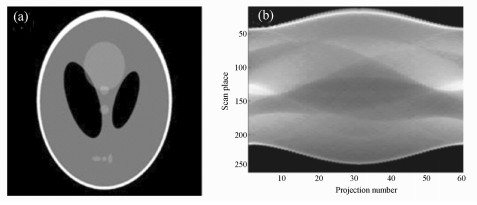
 Abstract
Abstract FullText HTML
FullText HTML PDF 4450KB
PDF 4450KB

